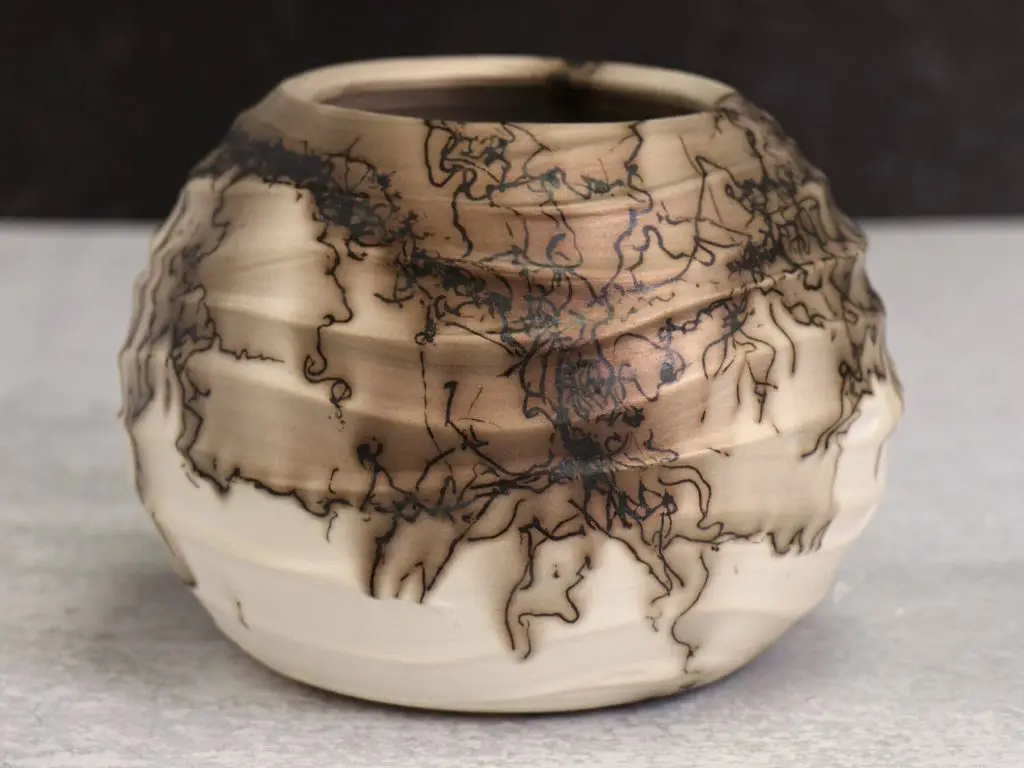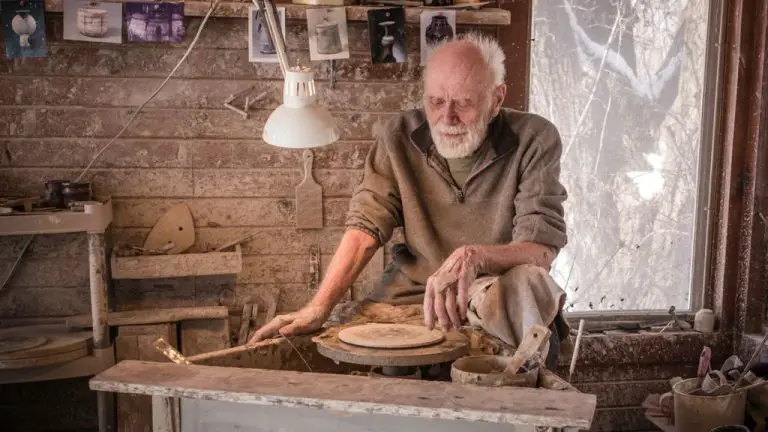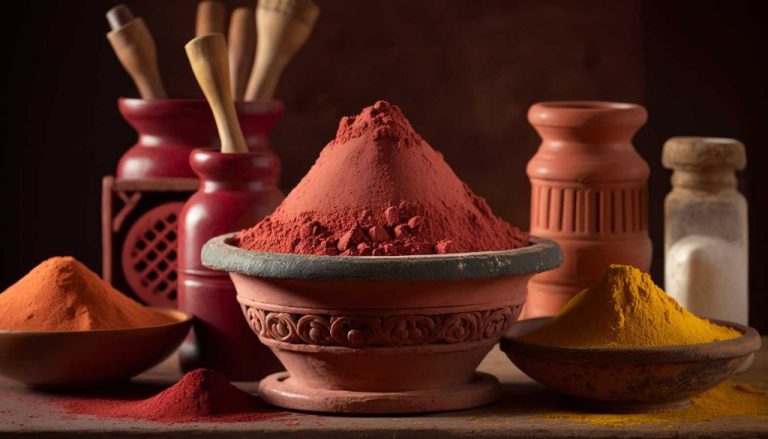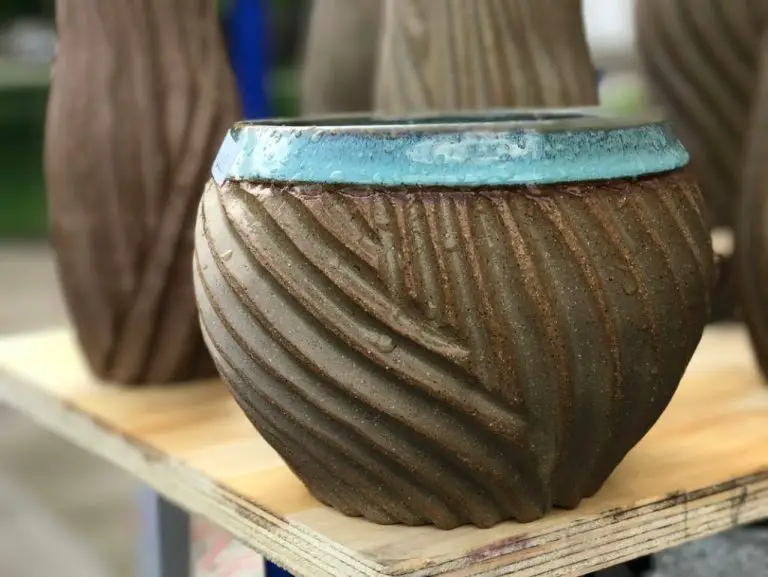What Is Horse Hair Pottery?
What is Horse Hair Pottery?
Horse hair pottery refers to a type of decorative ceramic ware where horse hair is applied to the raw clay before firing, leaving behind fine carbon lace-like designs on the surface. The technique originated among Native American tribes in the Southwestern United States in the early 19th century.
To create horse hair pottery, artisans shape wet clay into the desired form and allow it to dry and harden slightly. Horse hair is then laid across the surface in the desired pattern. When fired in a kiln, the hair burns away but leaves behind fine tracings from the carbon. Firing temperatures are usually between 1,600-2,000°F. The horse hair leaves a delicate black web-like design that contrasts with the colored clay body.
A defining characteristic of horse hair pottery is the web-like cracking patterns left by the burnt horse hair. The fineness and intricacy of the hair designs separates it from other burnished decorative techniques on ceramics. The horse hair carbon tracings are also very fragile and require careful handling.
Horse hair pottery originated among Pueblo Native American tribes such as the Acoma, Hopi, Zuni, and Navajo peoples. It continues as an important cultural ceramic tradition among Southwestern Native American artisans today. The unique aesthetic properties arise from both the horse hair technique as well as the firing methods that induce color effects on the clay.
Origins and History
The earliest known examples of horse hair pottery come from Native American Pueblo cultures in what is now the Southwestern United States, with pottery fragments dating back to around the 1600s found in archaeological sites in New Mexico (https://alltribes.com/southwest-decor/native-crafts/indian-pottery/horse-hair-pottery/). The technique likely developed as a way to decorate traditional Native American pottery using readily available natural materials. Horse hair was buried in the unfired clay which left behind carbonized lines when fired in a pit.
Over generations, horse hair pottery spread to tribes across the Southwest including the Acoma, Zuni, Hopi, and Navajo peoples. Regional styles emerged with differences in shape, design motifs, and firing methods. For example, Hopi artists incorporated carved designs along with horse hair while Navajo pottery had a smoother look from polishing. Innovations in technique also occurred like using different tools to create finer or thicker lines (https://www.kachinahouse.com/native-american-pottery/horsehair-pottery).
By the late 1800s, horse hair pottery was being produced in large quantities for trade with Anglo settlers. Non-native artists later adopted the technique which helped popularize it beyond the Southwest. Today it is a signature craft representing Southwestern Native American culture and artistry.
Making Process Explained
The creation of horse hair pottery involves several key steps and techniques:
- The clay body used is typically a smooth, high-fire stoneware or porcelain clay that can withstand the high temperatures required. Stoneware clays like Laguna’s Soldate 60 or porcelain clays like Standard 343 are common choices for horse hair pottery.
- The potter shapes the piece on a wheel or using handbuilding techniques. The surface of the piece is then carefully burnished or smoothed using a tool or cloth to compact the clay and create a smooth surface for the horse hair application.
- Strands of horse hair are then laid onto the leather-hard unfired pottery in the desired pattern. The hair can be laid in straight lines, wavy lines, or other artistic designs.
- A chemical reaction occurs when the horse hair burns away during firing, leaving behind carbon trails and textured lines on the clay surface. The proteins in the hair interact with the clay minerals to create these striking black carbon marks.
- The pottery is then bisque fired to over 1800°F. The high heat makes the hair burn completely away while creating the carbon reaction on the clay surface.
- After firing, potters may choose to add color washes or glazes over the carbon trails to accentuate the horse hair pattern.

This time-honored process transforms plain pottery into beautiful folk art pieces with intricate horse hair designs. The handmade quality and one-of-a-kind patterning give horse hair pottery its unique appeal.
Source: https://www.dilucaceramics.com/blogs/techniques/horsehair
Unique Aesthetic Properties
Horse hair pottery is renowned for its distinctive cracked and crazed surface patterns that result from the interaction between the horse hair and the clay during firing. The pottery develops fine, web-like cracking where the mane hair made contact, while broader, more irregular crazing occurs from the coarser tail hairs.
The specific aesthetic effects depend on variables like the type of clay used, the temperature of the kiln firing, and the amount of hair applied. For example, a higher kiln temperature causes more dramatic cracking, and a denser application of hair creates busier surface designs.
Compared to other decorative pottery styles that rely on glazes, paints, or carvings, horse hair pottery has an organic, natural-looking finish. The hair burns away in the kiln, leaving behind the unique crazing imprinted directly into the bare clay. This gives each piece a one-of-a-kind, handmade quality that highlights the potter’s skills.
As described on https://potteryhow.com/horse-hair-pottery/, “The cracked patterns resemble fractures on desert clay grounds, spiderwebs, or contours on a topographic map, making horse hair pottery revered for its rustic natural beauty.”
Regional Styles and Variations
Horse hair pottery techniques developed independently in several different cultures and regions around the world, resulting in distinct stylistic variations.
Native American potters in the Southwestern United States created horse hair wares with thicker walls and bolder, geometric patterns etched into the clay. The horse hair was often pressed in broad, swirling shapes rather than fine lines. Common colors included black, white, and terracotta.
In England, horse hair pottery from the Staffordshire region was known for thinner walls and more delicate, intricate horse hair patterns. Earthy tones like mustard yellow, olive green, and brick red were commonly used. The pottery forms themselves trended toward classic utilitarian shapes like mugs, plates, and storage jars.
Appalachian potters in the southeastern U.S. developed a unique horse hair style featuring white clay etched with very fine, dense horse hair lines in circular and geometric patterns. Their works ranged from functional crocks to decorative vases. The acclaimed potter Mark Hewitt continues this Appalachian horse hair tradition today.
No matter the origins, horse hair pottery worldwide shares common visual qualities of beautiful tonal contrasts, striking textures, and a sense of rustic, organic artistry.
Modern Uses and Artists
Despite its ancient origins, horse hair pottery continues to be practiced as a folk craft in many parts of the world. Potters in remote villages across Europe and Asia still employ traditional techniques to produce decorative wares glazed with horse hair. The unique visual effects achievable only through horse hair pottery are still treasured in these communities.
While remaining true to its roots, horse hair pottery has also seen renewed interest from contemporary ceramic artists. Modern potters are exploring new shapes, colors, and incorporating horse hair patterns into innovative mixed-media works. The striking organic patterns are a popular element in pots, sculptures, wall art, and abstract compositions. Prominent contemporary artists like Jennifer McCurdy are known for their horse hair pottery pieces that blend traditional craft with a modern artistic vision.
There have also been a number of gallery exhibitions featuring horse hair pottery in recent years. These exhibits aim to showcase the diverse global history of the medium as well as highlight innovative works by modern artists. Well-curated displays of antique and contemporary horse hair ceramics help viewers appreciate the enduring appeal of this singular art form.
Today’s potters clearly remain enamored with the serendipitous effects of horse hair firing, and continue to find new ways of incorporating this age-old technique into contemporary art.
Tips for Collecting Horse Hair Pottery
Horse hair pottery is highly prized by collectors for its unique aesthetic properties. When acquiring pieces for your collection, here are some tips to keep in mind:
Look for high-quality construction and artistic merit. Examine the shape of the vessel and the precision of the lines made by the horse hair. Authentic horse hair pottery has very fine lines etched into the surface. Modern examples sometimes have thicker, less delicate lines.
Search for makers marks or signatures that can help authenticate antique examples. Many Native American artists would sign their works. Marks can also indicate the age and origin of a piece. Styles and techniques varied by region and time period.
The Museum of Indian Arts and Culture in Santa Fe, New Mexico has an extensive collection of Native American pottery including many excellent examples of horse hair pottery that showcase different techniques and styles.
To care for horse hair pottery, avoid exposing pieces to rapid changes in temperature or humidity. Use museum wax to protect antique examples if displaying them. Handle with care as the fine etched lines can be prone to chipping or flaking over time.
Notable Examples and Masterworks
Horse hair pottery has been crafted for centuries, and over the years many remarkable pieces have been produced that demonstrate the artistry and skill involved.
Some of the most famous antique vessels are 18th century German milk pots. These were functional pots used for storing milk that often featured horse hair decorative elements. The horse hair provided an insulating layer to help keep the contents cool. German potters became renowned for their intricate hairwork on these milchtopf pots.
In the 19th century, the Hewell family of potters based in Wales created some signature works using horse hair. Thomas Hewell in particular was known for his masterful handles shaped like horse heads on pitchers and vases accented with fine horse hair designs.
Modern horse hair pottery artists have also produced innovative experimental pieces. Italian ceramicist Graziano Marini incorporates actual horse tail hairs into the clay for a 3D texture. Some of his horse hair vessels feature vivid colors like turquoise and purple paired with the natural black tails.
While traditional styles remain popular, these types of original horse hair pots demonstrate how artists continue to find new ways to work with this ancient technique.
Horse Hair Pottery in Popular Culture
Horse hair pottery has made several memorable appearances in popular culture over the years. Its rustic style and crackled surface have made it a popular prop and set decoration when trying to convey a sense of frontier living or Native American culture.
In film, horse hair pottery has been featured in classic Westerns like How the West Was Won and Dances with Wolves to convey the simple, handmade objects of the frontier era. More recently, it appeared as a set decoration in Nomadland and The Power of the Dog to evoke ranch life in the American West.
On television, horse hair pottery frequently shows up in shows like Deadwood, Godless, and Hell on Wheels when establishing the setting of late 19th century Western towns and outposts. Its presence helps create an authentic atmosphere.
In literary fiction, horse hair pottery is often used symbolically to represent the cracks and imperfections of rustic life. The poetry of Willa Cather and novels of Larry McMurtry both feature horse hair pottery as an emblem of the fading frontier. More modern books like Jeannette Walls’ memoir The Glass Castle use horse hair pottery to recall the bohemian childhood of the author.
In the visual arts, some painters like Georgia O’Keeffe have featured horse hair pottery in their depictions of the Southwest to capture its indigenous artistic traditions. Photographers like Ansel Adams have also made horse hair pottery an emblem of Native American culture.
Overall, horse hair pottery remains a compelling symbol of handcrafted artistry and rustic living in many creative works across film, television, literature, and other media. The cracked surface and organic imperfections make it visually arresting and useful as an evocative prop. As an authentic Native American art form, it also conveys the indigenous cultures of the American West.
The Enduring Appeal of Horse Hair Pottery
Horse hair pottery continues to captivate artists and collectors alike due to its satisfyingly hands-on creative process, rustic old-world aesthetic, and connections to cultural traditions. Unlike mass-produced modern pottery, each hand-built piece with intricately woven horse hair is utterly unique. The textural quality and natural flaws of the clay combined with the organic shapes of real horse hair result in a one-of-a-kind decorative item brimming with rustic charm. This type of pottery is still practiced mainly for its cultural significance among Native American tribes like the Navajo, who have passed down time-honored techniques over generations. Preserving and honoring these ancestral artistic traditions is a key part of horse hair pottery’s ongoing appeal. As noted by AllTribes.com, “Some people believe the technique was first introduced by Native Americans because it has been so prevalent among Native American artists.” The authentic, earthy aesthetic and personal touches attract art collectors and homeowners looking to display these uncommon works of art (https://alltribes.com/southwest-decor/native-crafts/indian-pottery/horse-hair-pottery/). The labor and skill involved in creating quality horse hair pottery, as well as its roots in Southwestern Native American culture, help explain its enduring and growing popularity.




